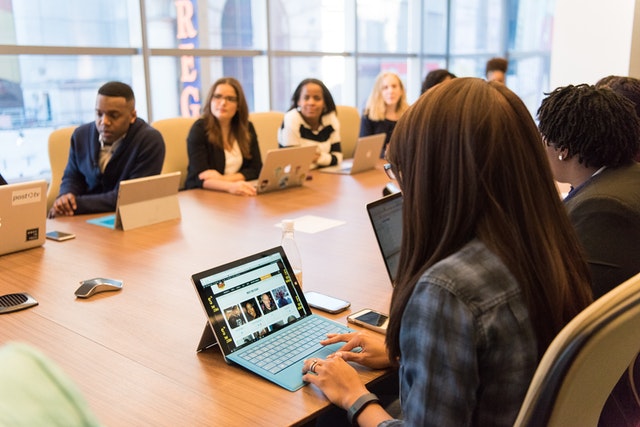Human Resources

9 Types of Diversity in the Workplace

13 August 2021 - 3 min read
In the working world, it’s incredibly important to be aware of the diverse set of people you connect and work with on a daily basis.
The issue, however, is that what makes people unique isn’t always obvious - so paying attention, keeping an open mind, and practicing inclusion are key to making sure your diverse workplace continues to thrive.
To provide more insight, below we’ve put together a guide about the 9 types of diversity in the workplace you should be aware of.

Types of Diversity at Work
1. Age
In every organisation, the ages of those that make up the employee population are usually widespread, offering a large variety of experiences based on which generation they were born into and where they might come from.
This means that someone who is in their twenties will potentially have an entirely different (and perhaps more ‘modern’) skill set than someone approaching their fifties, who may have a more traditional set of business skills.
These differences can sometimes cause challenges at work, however, ageism being one of the toughest among them, which is the tendency to aim negative feelings and stereotypes towards others due to their age.
In fact, a recent study found that a whopping 71% of UK workers feel that ageism in their workplace is common. The same study also found that 76% of 25 to 34-year-olds have dealt with discrimination for being ‘too young’ at work, while 89% of 45 to 55-year-olds have been discriminated against for being ‘too old’.
To this end, it’s clear that the conversation around age diversity still needs work and should emphasise that employees of all ages are key to driving both innovation and the economy forward - a notion that businesses should actively embrace through their hiring and retention strategies.
2. Race & Ethnicity
While race refers to the physical differences that groups and cultures consider socially significant (i.e. skin colour, facial features, and stature), ethnicity refers to shared social, cultural, and historical experiences (i.e. language, ancestry, practices, and beliefs) that stem from common national or regional backgrounds that make up the ethnic subgroups of a population different from one another.
It’s important to distinguish these two terms because they are often used interchangeably, and it causes a lot of confusion. Most sociologists, for instance, feel that race is entirely a social construct while ethnicity avoids the biological connotations that race is associated with and focuses on learned behaviours.
This means it’s important to remember that individuals who might look similar may actually be entirely different in both race and ethnicity. When we make assumptions, on the other hand, we risk creating toxic, non-inclusive working environments - negatively impacting employee morale and, ultimately, an organisation’s bottom line.
3. Education & Income
Education varies all over the world depending on location, institution, and those teaching the material. It’s also often heavily influenced by law and government requirements, meaning what individuals of different countries or even varying regions learn will create, for them, an entirely diverse narrative for how they view the world around them.
To add, while not always related, the level of education an individual has (not to mention their race, gender, and ethnicity) tends to relate to where they’ll land in their current or future career, and subsequently, what their income will be. It’s also important to remember that someone’s degree (or lack thereof) may not have the same leverage in one country - or even in one company - as it does in another.
Some organisations, however, are no longer requiring candidates to have a higher degree when applying for roles. Instead, employers are focusing on experience and soft skills to qualify candidates, leaving the door open to those with more diverse, non-traditional backgrounds.
That’s why it’s important to remember that with or without formal education, everyone you meet knows something you don’t. This gives us the opportunity to learn from each other and learn not to put too much emphasis on the value of someone’s education as it relates to their level of knowledge.

4. Skills & Abilities
Without a doubt, one of the largest (but often less obvious) pools of diversity in the workplace includes that which makes up the skills and abilities of its employees.
Depending on their professional history, employees will be hired - or not - based on their particular skills sets, making this type of diversity incredibly important to the recruitment process.
People naturally have different strengths based on their personal experiences and professional background, and these characteristics (i.e. emotional intelligence and enhanced leadership abilities) are what create a positive culture that empowers employees to thrive and excel in their roles.
We’d also be remiss if we didn’t include those with disabilities in this section, as this type of diversity is just as important as any other. Whether mental or physical, those with disabilities bring with them unique perspectives of the world and the workplace, and, just like everyone else, they have the skills and abilities to have great success as standout employees.
When organisations make sure to include those with varying skills sets, abilities - and disabilities - they empower people to be more empathetic and understanding of one another as individuals while being inspired by their strengths.
5. Family & Upbringing
People live their lives according to or in spite of the different backgrounds, families, values, and beliefs they grew up with, and as such, these elements become the framework for our own sense of individuality.
No matter what an employee’s family situation is, however, employers should make an effort to understand that everyone has a unique set of obligations and commitments outside of work to the ones they care about, whether it be their grandma or a beloved border collie.
Providing perks, such as flexible and remote working hours, encourages employees to have close relationships with their friends and family, enhancing their work-life balance while keeping their mental health and wellbeing in check.
6. Personality Types
No person is exactly the same, and it’s a beautiful thing, however, organisations often cater to specific types of people because they make the mistake of assuming their employees are similar simply because they work in the same industry.
For example, many offices cater to extroverts over introverts by implementing an open plan office space and desk sharing, which can sometimes be uncomfortable for introverts who are typically more reserved.
Ice breakers, onboarding, and training exercises are also more often created with those who are more extroverted in mind and can actually be quite anxiety-inducing for those who perhaps aren’t as comfortable in the limelight.
However, personality diversity isn’t simply separated by introversion and extroversion. Myers Briggs, for instance, claims there are sixteen varying personality types while other methods focus more narrowly on specific traits and characteristics.
So, while it’s true that each of us can fit into a particular category, at the end of the day we’re still all individuals with varying morals, values, hobbies, and strengths and it’s important for organisations to address that and implement training and retention strategies accordingly - the one size fits all approach is officially old and outdated.

7. Gender Identity & Expression
The social constructs surrounding gender roles vary from one culture to another, however, within most, individuals are assigned these roles at birth based on biological sex. Once this assignment happens, individuals are more or less segregated into male or female gender binaries.
These days, however, things have progressed beyond these two distinct (and constricting) binaries, with society now beginning to accept that there is, in fact, a spectrum of gender identities that may or may not correspond with the sex a person was assigned at birth. These identities include - but are not limited to - transgender, non-binary, genderqueer, non-gendered, and gender fluid.
To add, gender expression - how someone expresses themselves externally - may also vary from an employee’s sex or gender identity. This can be interpreted through elements such as hair, makeup, mannerisms, behaviour, clothing, and preferred pronouns.
To remain inclusive of gender diversity and expression at work, organisations should practice the following:
- Educating their teams about the different gender identity terms
- Politely asking potential and current employees what their preferred gender pronouns are
- Consider creating an Employee Resource Group to support LGBTQ+ employees, and
- Ensuring that part of company spend is utilised toward supporting diversity goals
8. Sexual Orientation
Different from gender identity, expression, and biological sex, sexual orientation can be defined as an ‘inherent emotional, romantic, or sexual attraction to other people’. In other words, sexual orientation refers to a person’s identity in relation to the gender or genders to which they’re attracted to.
Common sexual orientations include heterosexual, bisexual, lesbian, gay, asexual, pansexual, and questioning. While to many of us these terms are known, accepted, and acknowledged in the workplace, in over half of the world, LGBTQ+ employees actually still face a huge lack of legal protection from employment discrimination.
So, while the world plays catch up in advocating for this incredible and diverse community, employers can still work to create an inclusive workforce by learning about current issues and laws as they relate to LGBTQ+ employees and educating those in their organisation on them as well.
9. Neurodiversity
A term used to describe how the brain varies from person to person, neurodiversity focuses on neurodivergent people, including those with autism, ADHD, epilepsy, Tourette syndrome, and dyslexia (among others).
In the past, these conditions were often seen as disabilities that needed to be fixed or treated, however, the idea behind neurodiversity is accepting that these conditions aren’t disabilities but are instead simply differences between the way people think.
When organisations prioritise hiring and supporting neurodiverse individuals at work, they’re making a statement that they value the way different people think and perceive the world around them, ultimately offering organisations a broader range of skills, experiences, personalities, etc problem solving and innovations.
Download Your Free CIPD Course Guide
Get information on our CIPD courses
Share this post
To remain diverse and inclusive, it’s important to remember that no individual is the same. By doing this, we can combat unconscious bias, enhance our world views, and create a diverse workforce that we’re proud to be part of.
Free your potential and diversify your HR skillset with a professional 100% online CIPD qualification.












